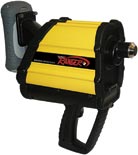When time is short and resources are limited, this hand-held device brings the lab to the scene.
Point and Click
- By Marc Barrera
- Sep 01, 2008
 The American landscape was forever changed by the events of
9/11.With the anthrax mail scare that followed shortly afterward,
one company found itself in a unique
position to help the emergency responder
community with a portable chemical identifier
called HazMatID™.
The American landscape was forever changed by the events of
9/11.With the anthrax mail scare that followed shortly afterward,
one company found itself in a unique
position to help the emergency responder
community with a portable chemical identifier
called HazMatID™.
Several years and many technological advances
later, Danbury, Conn.-based Smiths Detection unveiled
its updated model, the HazMatID Ranger, in
late May at the International Association of Fire
Chiefs’ 2008 exhibit.Aaron Gagnon, assistant director
of Product Management, said many of the
changes in the Ranger model have been made to improve
its transportability. “What we’ve done is taken
the HazMatID and we’ve miniaturized the electronics
and some other things, and we’ve created the
HazMatID Ranger, which allows for one-hand operation
and is controlled via Bluetooth by a PDA,” he
said. Its dramatic drop in product weight from 23 to
6.5 pounds further served to broaden the product’s
portability, Gagnon added. “It allows the responder
to go and run many samples over great distances,
and they can fit in tighter spaces if they need to.”
Gagnon said the combination of an attached
strap with a one-handed, trigger-type design further
contributes to its ease of use. “You can actually drive
the software by squeezing a trigger similar to a cordless
drill,” he said. “So it has a very robust feel, very industrial feel
that our customers really have gotten to liking.”
Perhaps the most significant improvement is the device’s detachable,
rugged PDA; the previous model had an integrated computer
that was built into the system. This Bluetooth wireless-enabled
PDA is especially helpful for hazmat personnel, Gagnon
noted. “The ability to remove the PDA is important, because usually
these users will go in with two people, and they have what we call
a ‘dirty person’ and a ‘clean person,’” he said. “One person may have
the PDA in their hand, while the other person has the HazMatID
Ranger and is going to identify the sample. So they can remotely
control it within the limits of Bluetooth.”
Crunching the Numbers
With all of the changes made to the device, one feature remains
constant: its extensive database. The HazMatID Ranger draws from
a library of more than 32,000 materials, which includes suspicious
white powders,WMDs, explosives, toxic chemicals, and more.
“The large databases we have are all owned by Smiths Detection.
We may have collaborations with large chemical plants or we
have collected the data ourselves, but all of the data is run on our
very own system. These are not just large databases purchased in.
We’ve actually taken, run, and quality-checked all the data on our
own instrumentation,” Gagnon said, adding that the only exception
to this is when limitations force them to seek collaborations.
“For example, if we wanted to create a narcotics library or an explosives
library or a chemical warfare agent library, we can’t run
those materials in our own labs, so we’ll actually have collaboration
with the government or other agencies that may have these
materials in their possession.”
As an additional safety net, in the event a material
cannot be identified or the user simply wants confirmation
of a reading, the system is supported by
ReachBack™, a 24-hour, 365-days-a-year technical
assistance support program.“If the material is not
identified, you can call a Ph.D.-level chemist and
they can help you further analyze the data, or you
can actually use the chemist to confirm what the
emergency responder has actually gotten in the
field,” he said.
Identifying Chemicals and Components
Of course, good data is impossible without good
sampling. The HazMatID Ranger uses Fourier
Transform Infrared technology, which has been
around for decades and is used in laboratories,
pharmaceuticals, forensics, and more.When its
diamond sensor tip touches a sample, the device
will provide both spectral results and a list of
probable substances to help identify chemicals
and also components in mixtures. “Not only can
you use it in an emergency response situation, but
you can use this type of technology to confirm a
certain chemical,” Gagnon said. “So if you get a
shipment
of material at a chemical
plant and you want to
confirm that it is what it
says it is in that label, you
can use the HazMatID
Ranger for that.”
At the end of the day,
Gagnon noted, the device is
designed to be as easy to clean
as it is to use. “The HazMatID system, not
including the PDA, can be submerged into
a bucket of bleach for an extended period
of time; usually, the standard operating
procedure is 30 minutes,”
he said. “That’s done to
clean the system so if it
comes in contact with
something nasty—
whether it’s a biological agent, a chemical warfare agent, or something
along those lines—the first responder is going to want to
know that the system is clean.”
This article originally appeared in the September 2008 issue of Occupational Health & Safety.